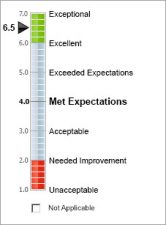Why don’t clients to tell us exactly what they need? How can we deliver to their expectations without that information? What is all this guess work doing to our bottom line? You may be asking yourself these questions, and if you’re not, you should be.
Case Study
Recently, a 400-person construction firm sent a baseline feedback request to its top 50 Clients. They used Client Savvy’s unambiguous perception meter within the Client Feedback Tool to determine if they were delivering what is expected from the client and what the overall perception of the firm was. Firm leadership planned to use the data and analytics to determine their top strategic priorities and “Best Practices” for the firm.
Unexpected Insight
The firm thought they were well aligned with their clients’ expectations, but what they found was shocking. Thirty of the 50 accounts – sixty percent! - responded with unanimous “Way above expectations” scores. The firm had substantially exceeded expectations for management of project budgets and schedules, quality and accuracy of information shared, and most importantly helpfulness and responsiveness.
So that’s great, right? Or is it?
While over delivering and exceeding expectations certainly delighted their clients, our research on more than 500K client perception surveys shows that substantially exceeding expectations means you are quite possibly giving your client a lot more than they ever asked you to deliver.
Firm leaders had not anticipated that their drive to “do, do, do” for clients was the cause for profitability concerns. After sending the baseline feedback request, they recognized that this over delivery on expectations had likely caused a chain reaction decreasing the firm’s profitability significantly.
When they reviewed the data and spoke with some of their project managers (PMs), the firm found that many of their PMs were spending a ton of time doing things for their clients that were ’nice to have’ but were not a ’must have’ and were not written into the scope of the project. The client had no expectation of these extras being delivered. Since these nice-to-have items were not in the scope of service, and since the client hadn’t asked for the additional efforts, the PMs were not charging for the work!
Consider the domino effect on the firm’s profitability. The additional time spent on projects outside scope (and fee), ate into the firm’s profit for multiple reasons:
- Team member charged additional hours to the project without a change order to cover the additional scope, the profitability of the projects suffered.
- Team members, including PMs, working on these projects could not be utilized for other projects, creating an opportunity cost and affecting the firm’s ability to scale. Everyone was busy, and their utilization rates were high, but those hours could have been spent (and billed) working on other projects or on business development efforts, generating additional revenue and profit.
- Project Managers (and their teams) were feeling burnt out. Project Managers, not knowing what the clients’ perceptions were, mistakenly over-produced to “keep clients happy.” By working harder while producing less and less effective results internally, the assumptions they made caused a lot of unwanted and unnecessary stress. Late nights and weekends led to good employees “on the edge” turning to conflict instead of collaboration. Increasing stress and toxicity on the team resulted in higher than desired turnover within the department. The cost to the firm of this turnover (on average of $75,0001 per loss) clearly has a negative effect on their profits and morale.
Critical Questions
What can you do to avoid making assumptions related to what your clients want and/or need from your firm?
- How will you confirm assumptions and avoid the common mistake of over (or under) serving the client?
- How will you put this information into the hands of all your front-line employees, to manage their behavior?
- How will you know whether to scale back services to match expectations, or increase your prices to meet the additional value you’ve created?
Managing Risk
In professional services, the difference between understanding a client’s needs exactly and assuming their needs can mean tens of thousands of dollars in profitability. On one large project, a firm realized they made a $250k pricing mistake (and fixed it!). Multiply the lost dollars on 60% of your projects and it will equate to significant dollars. This lack of clarity creates a domino effect that impacts many other aspects of your business.
The Path to a Solution
How can you avoid leaving money on the table while burning out staff? Create a Client Experience (CX) Playbook for your firm with a clear definition of the experience you want your clients to have working with your firm. There is no right, or wrong definition and every firm’s definition will be different. The important piece is that everyone in your firm understands what it is and what their response should be in different situations. Then your staff can clearly communicate expectations to the clients and stay more closely aligned at every step of the project.
Providing your team with clear client perception insights removes the assumptions that they have to overproduce and creates a clear path to consistent profits. When everyone knows how to respond in “overproduction” situations, they have the confidence to scale back, deliver on the firm’s brand promise while staying in scope, and still deliver a delightful client experience.
1 Apple One Turnover Calculator - https://www.appleone.com/Employers/SCALE/2018/Retain/cost-of-turnover-calculator.aspx






